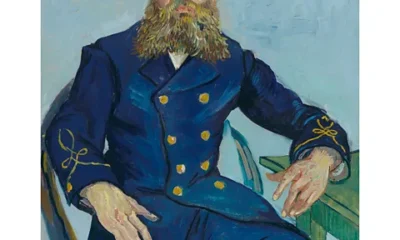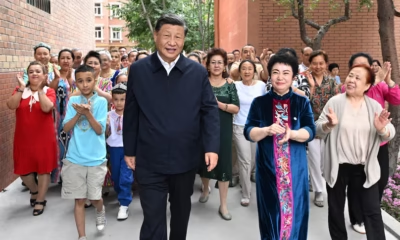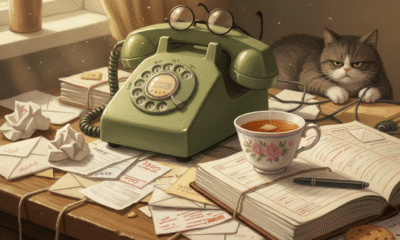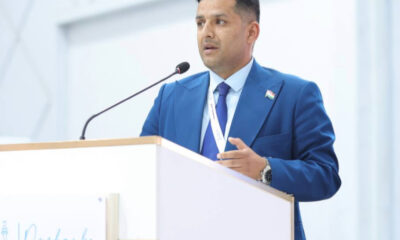Art & Culture
‘Her meaning contains multitudes’: Why the Statue of Liberty is at the heart of US culture wars

Controversy over an Amy Sherald painting of the Statue of Liberty reveals divides over US national symbols, joining debates that have centred on the statue since it was first unveiled.
So fixed is our focus on the radiant points of her spiky crown and the upward thrust of her flickering lamp, it is easy to miss altogether the shackles of human enslavement that Lady Liberty – who is at the centre of a fresh skirmish in the US’s accelerating culture wars – is busy trampling underfoot. Her meaning contains multitudes. It pulls her in many directions.
Messily inspired, as all great art is, by a mixture of sources – from the Roman goddess Libertas, to the Greek sun god Helios, to the multifaceted Egyptian goddess Isis (who fascinated the sculpture’s creator, the French artist Frédéric-Auguste Bartholdi) – the Statue of Liberty seems hardwired for debate. She boldly embodies the one straightforward truth about cultural symbols: their truths are never straightforward.
From the moment the statue was unveiled in October 1886, it provoked criticism from both ends of the political spectrum
The current controversy over the essence of Bartholdi’s 46m (151ft)-tall copper sculpture, ingeniously engineered by Gustave Eiffel and formally presented to the United States as a gift from France on 4 July 1884, is a striking painting by African American contemporary artist Amy Sherald that reimagines the Statue of Liberty as a black transgender woman.
Earlier this month, Sherald, best known until now for her 2018 official portrait of First Lady Michelle Obama, was advised that her work, Trans Forming Liberty, might upset US President Donald Trump – who in January issued an Executive Order recognising two sexes only – male and female – and therefore should not be included in her upcoming exhibition at the federally funded Smithsonian’s National Portrait Gallery in Washington, DC. Rather than contemplate removing the work, Sherald decided to cancel the show altogether, citing “a culture of censorship”.
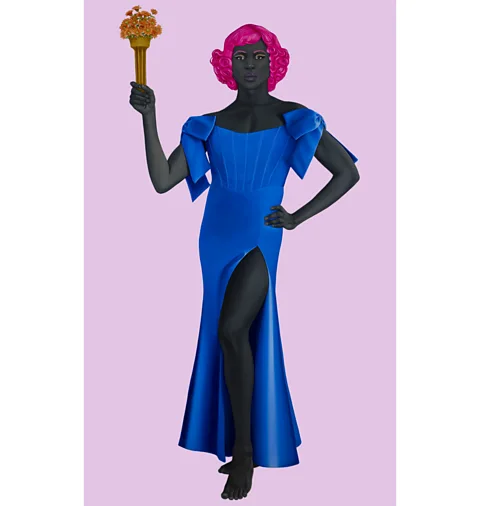 The Whitney Museum
The Whitney Museum
The contested work is currently on display at New York’s Whitney Museum as part of Sherald’s touring exhibition American Sublime and is characteristic of the artist’s instinct to dislocate her subjects and unsettle expectations. Sherald often achieves this, as she does both in her portrait of Obama and in Trans Forming Liberty, by translating her subjects’ complexions into an uncanny greyscale (or “grisaille”), nudging viewers to look past skin colour and reassess their assumptions about what constitutes race. The model for Sherald’s work, Arewà Basit, a black artist who identifies as non-binary trans-femme, is portrayed against a flat, periwinkle background, hand on hips, wearing a vibrant ultramarine gown that recalls the otherworldly resplendence of Renaissance Madonnas, and neon fuschia hair.
The torch she lifts has been supplanted by a clutch of humble Gerbera daisies, traditionally a symbol of joy and hope – a subtle subversion that faintly calls to mind the disarming weapon wielded by Banksy’s Flower Thrower, who too is powerful in his powerlessness. Of the intended potency of her own work, Sherald has explained that her painting “exists to hold space for someone whose humanity has been politicised and disregarded” – a sentiment that arguably rhymes with the hospitable spirit of the statue itself, which is famously affixed with a sonnet by Emma Lazarus, summoning “homeless, tempest-tossed” “masses yearning to breathe free”.
A polarising symbol
That synchronicity, however, may be both the painting’s profoundest allure and deepest liability. From the moment the statue was unveiled in October 1886, it provoked criticism from both ends of the political spectrum. Suffragettes insisted the sculpture’s depiction of a woman embodying liberty was too ironic to be taken seriously when women themselves were denied the right to vote. At the same time, conservatives objected to any incitement of migrants to flock to the US – those “huddled masses” the sculpture silently summons. By recasting Lady Liberty as a totem of unfulfilled promise, Sherald’s work aims to send a tremor down the fault-line of the American conscience.
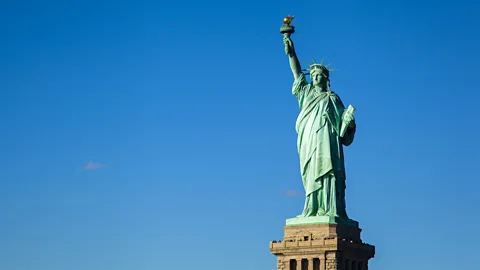 Getty Images
Getty Images
While neither Trump nor anyone in his administration has, as yet, publicly condemned Sherald’s painting or its representation of a black transgender woman, the organisers of her scheduled exhibition, which was due to open on 19 September, had reason to fear imminent repercussions to its funding should the work go on display. In March, barely two months into his second term, Trump signed an Executive Order entitled “Restoring Truth and Sanity to American History”, which is aimed at curtailing financial support to museums and projects that, in its words, “degrade shared American values, divide Americans based on race, or promote programs or ideologies inconsistent with Federal law and policy”. Stating that the Smithsonian had “come under the influence of a divisive, race-centered ideology”, Trump instructed US Vice-President JD Vance to enforce his order. It was only a matter of time before Sherald’s recasting of Lady Liberty as black and transgender would catch Vance’s eye.
More like this:
• The real meaning of Van Gogh’s Sunflowers
• Who was the real Andy Warhol?
• The naked billboard that shocked the establishment
It was after meeting with Vance, who according to an anonymous source quoted by Fox News expressed concerns about the “woke” nature of Sherald’s work, that organisers of Sherald’s show began having second thoughts about including the painting in the exhibition – triggering the artist’s subsequent withdrawal from the project altogether. In recent months, enforcement of Trump’s Executive Order has intensified clashes over what kind of story the country’s symbols tell – or should be permitted to tell.
The exclusion of Sherald’s painting from public view has likely only amplified its exposure and impact. What’s more visible than something hidden?
Among the notable flashpoints is Independence National Historical Park in Philadelphia, Pennsylvania, home to the Liberty Bell. The White House has given the institution until the end of July 2025 to apply to all of its programmes a review to ensure that the narratives it projects “remind Americans of [the nation’s] extraordinary heritage, consistent progress toward becoming a more perfect Union, and unmatched record of advancing liberty, prosperity”. Particular issue has reportedly been taken with the Park’s inclusion in its displays of information relating to the ownership of slaves by America’s first President, George Washington, to the brutality that slaves suffered, and to the treatment of Native Americans.
Whatever is ultimately decided about the texture and tone of the exhibits at the Independence National Historical Park and of those at other federal museums and institutions now undertaking reviews, the resonance of cultural symbolism is difficult to control no matter how strenuously a government may try. Some bells can’t be unrung. Cracks remain. The exclusion of Sherald’s painting from public view has likely only amplified its exposure and impact. What’s more visible than something hidden?
As for Lady Liberty herself, Eiffel’s proleptic reliance when constructing the statue on a pliable wrought-iron pylon framework that functions like a network of springs, enabling the sculpture’s thin skin to flex and clench without breaking, has ensured the sculpture’s survival against the unpredictable buffets of time. Will the elastic meaning of liberty itself prove as resilient?
Amy Sherald’s exhibition American Sublime is at the Whitney Museum in New York City until 10 August.
—
If you liked this story, sign up for The Essential List newsletter – a handpicked selection of features, videos and can’t-miss news, delivered to your inbox twice a week.
For more Culture stories from the BBC, follow us on Facebook and Instagram.
Art & Culture
Joy and Sorrow: A Reflection on Inequality and Human Connection by Zeenat Iqbal Hakimjee from Harmony
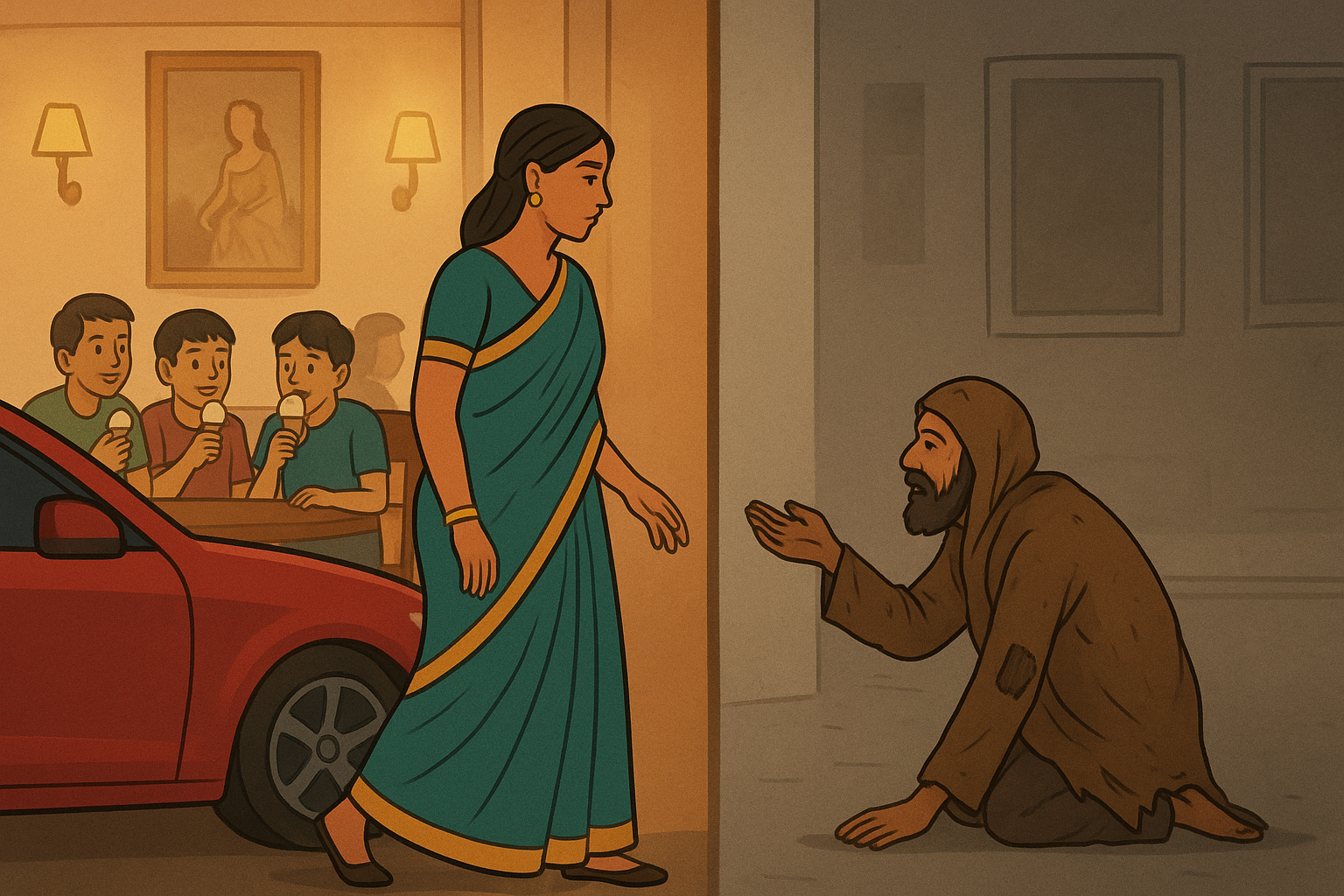
The begum dashes by in –
– Her flashing car,
To meet a companion at –
– A destination afar.
At a meeting point
In a parlour,
Five boys voraciously
In a corner ice Cream devour,
The silk saris and golden bangles
Glittering in the light,
The high heels and the leather purses
Presenting a sight;
The beggar in his torn
and tattered assemblage,
Spreads out his palm
And asks for patronage.
Art & Culture
“Confessions Beneath the Barrel” A city mourns as a poet captures the terror within a man’s own making—a chilling reflection on Karachi’s fractured heart.

Possessed by the devil,
I strode out to do evil.
With enmity written large on my face,
Somebody has to be dad in deaths embrace.
Just yesterday a child became an orphan,
And a couple were worried by the ransoms burden.
The fetters of depression behold the city,
Where everyday criminals like me enter captivity.
Karachi, Karachi of yore
Shall hot surface will not surface
Whilst I trigger my double barrel bore.
Art & Culture
‘A very deep bond of friendship’: The surprising story of Van Gogh’s guardian angel
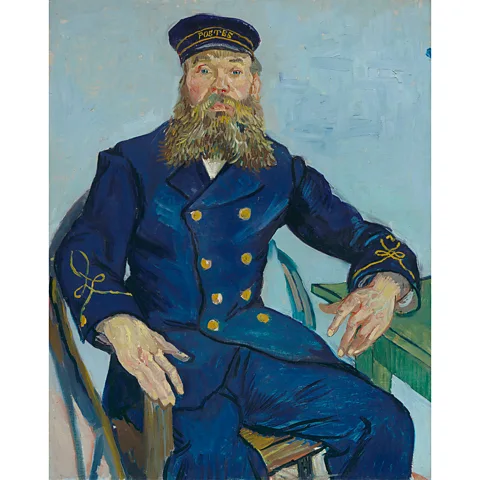
At the toughest, most turbulent time of his life, the Post-Impressionist painter was supported by an unlikely soulmate, Joseph Roulin, a postman in Arles. A new exhibition explores this close friendship, and how it benefited art history.
On 23 December, 1888, the day that Vincent van Gogh mutilated his ear and presented the severed portion to a sex worker, he was tended to by an unlikely soulmate: the postman Joseph Roulin.
A rare figure of stability during Van Gogh’s mentally turbulent two years in Arles, in the South of France, Roulin ensured that he received care in a psychiatric hospital, and visited him while he was there, writing to the artist’s brother Theo to update him on his condition. He paid Van Gogh’s rent while he was being cared for, and spent the entire day with him when he was discharged two weeks later. “Roulin… has a silent gravity and a tenderness for me as an old soldier might have for a young one,” Van Gogh wrote to Theo the following April, describing Roulin as “such a good soul and so wise and so full of feeling”.
Paying homage to this touching relationship is the exhibition Van Gogh: The Roulin Family Portraits, opening at the MFA Boston, USA, on 30 March, before moving on to its co-organiser, the Van Gogh Museum, Amsterdam, in October. This is the first exhibition devoted to portraits of all five members of the Roulin family. It features more than 20 paintings by Van Gogh, alongside works by important influences on the Dutch artist, including 17th-Century Dutch masters Rembrandt and Frans Hals, and the French artist Paul Gauguin, who lived for two months with Van Gogh in Arles.
Roulin wasn’t just a model for Van Gogh – this was someone with whom he developed a very deep bond of friendship – Katie Hanson
“So much of what I was hoping for with this exhibition is a human story,” co-curator Katie Hanson (MFA Boston) tells the BBC. “The exhibition really highlights that Roulin isn’t just a model for him – this was someone with whom he developed a very deep bond of friendship.” Van Gogh’s tumultuous relationship with Gauguin, and the fallout between them that most likely precipitated the ear incident, has tended to overshadow his narrative, but Roulin offered something more constant and uncomplicated. We see this in the portraits – the open honesty with which he returns Van Gogh’s stare, and the mutual respect and affection that radiate from the canvas.
A new life in Arles
Van Gogh moved from Paris to Arles in February 1888, believing the brighter light and intense colours would better his art, and that southerners were “more artistic” in appearance, and ideal subjects to paint. Hanson emphasises Van Gogh’s “openness to possibility” at this time, and his feeling, still relatable today, of being a new face in town. “We don’t have to hit on our life’s work on our first try; we might also be seeking and searching for our next direction, our next place,” she says. And it’s in this spirit that Van Gogh, a newcomer with “a big heart“, welcomed new connections.
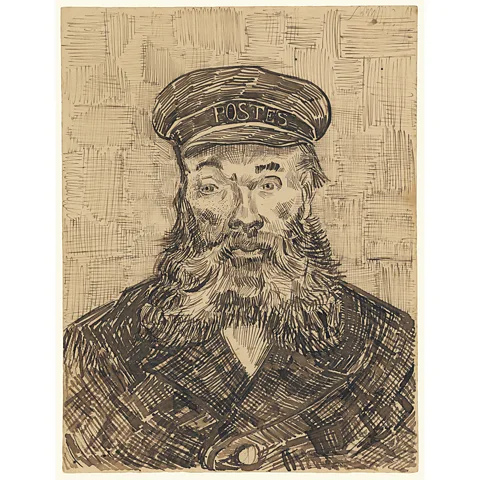
Before moving into the yellow house next door, now known so well inside and out, Van Gogh rented a room above the Café de la Gare. The bar was frequented by Joseph Roulin, who lived on the same street and worked at the nearby railway station supervising the loading and unloading of post. Feeling that his strength lay in portrait painting, but struggling to find people to pose for him, Van Gogh was delighted when the characterful postman, who drank a sizeable portion of his earnings at the café, agreed to pose for him, asking only to be paid in food and drink.
ADVERTISING
Between August 1888 and April 1889, Van Gogh made six portraits of Roulin, symbols of companionship and hope that contrast with the motifs of loneliness, despair and impending doom seen in some of his other works. In each, Roulin is dressed in his blue postal worker’s uniform, embellished with gold buttons and braid, the word “postes” proudly displayed on his cap. Roulin’s stubby nose and ruddy complexion, flushed with years of drinking, made him a fascinating muse for the painter, who described him as “a more interesting man than many people”.
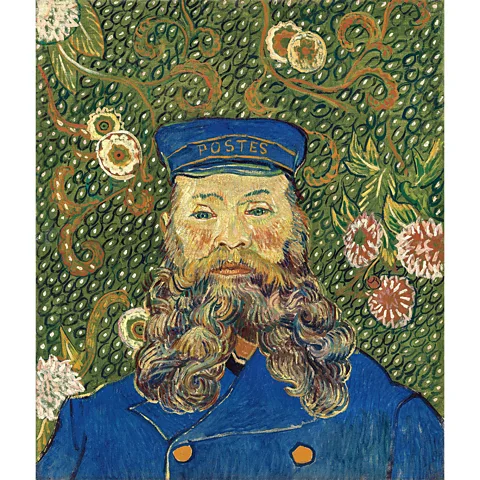
Roulin was just 12 years older than Van Gogh, but he became a guiding light and father figure to the lonely painter – on account of Roulin’s generous beard and apparent wisdom, Van Gogh nicknamed him Socrates. Born into a wealthy family, Van Gogh belonged to a very different social class from Roulin, but was taken with his “strong peasant nature” and forbearance when times were hard. Roulin was a proud and garrulous republican, and when Van Gogh saw him singing La Marseillaise, he noticed how painterly he was, “like something out of Delacroix, out of Daumier”. He saw in him the spirit of the working man, describing his voice as possessing “a distant echo of the clarion of revolutionary France”.
The friendship soon opened the door to four further sitters: Roulin’s wife, Augustine, and their three children. We meet their 17-year-old son Armand, an apprentice blacksmith wearing the traces of his first facial hair, and appearing uneasy with the painter’s attention; his younger brother, 11-year-old schoolboy Camille, described in the exhibition catalogue as “squirming in his chair”; and Marcelle, the couple’s chubby-cheeked baby, who, Roulin writes, “makes the whole house happy”. Each painting represents a different stage of life, and each sitter was gifted their portrait. In total, Van Gogh created 26 portraits of the Roulins, a significant output for one family, rarely seen in art history.
Van Gogh had once hoped to be a father and husband himself, and his relationship with the Roulin family let him experience some of that joy. In a letter to Theo, he described Roulin playing with baby Marcelle: “It was touching to see him with his children on the last day, above all with the very little one when he made her laugh and bounce on his knees and sang for her.” Outside these walls, Van Gogh often experienced hostility from the locals, who described him as “the redheaded madman”, and even petitioned for his confinement. By contrast, the Roulins accepted his mental illness, and their home offered a place of safety and understanding.
The relationship, however, was far from one-sided. This educated visitor with his unusual Dutch accent was unlike anyone Roulin had ever met, and offered “a different kind of interaction”, explains Hanson. “He’s new in town, new to Roulin’s stories and he’s going to have new stories to tell.” Roulin enjoys offering advice – on furnishing the yellow house for example – and when, in the summer of 1888, Madame Roulin returned to her home town to deliver Marcelle, Roulin, left alone, found Van Gogh welcome company.
Roulin also got the rare opportunity to have portraits painted for free, and when, the following year, he was away for work in Marseille, it comforted him that baby Marcelle could still see his portrait hanging above her cradle. His fondness for Van Gogh shines through their correspondence. “Continue to take good care of yourself, follow the advice of your good Doctor and you will see your complete recovery to the satisfaction of your relatives and your friends,” he wrote to him from Marseille, signing off: “Marcelle sends you a big kiss.”
Van Gogh lived a further 19 months, producing a staggering 70 paintings in his last 70 days, and leaving one of art history’s most treasured legacies
Van Gogh’s portraits placed him in the heart of the family home. In his five versions of La Berceuse, meaning both “lullaby” and “the woman who rocks the cradle”, Mme Roulin held a string device, fashioned by Van Gogh, that rocked the baby’s cradle beyond the canvas, permitting the pair the peace to complete the artwork. The joyful background colours – green, blue, yellow or red – vary from one family member to another. Exuberant floral backdrops, reserved for the parents, come later, conveying happiness and affection – a blooming that took place since the earlier, plainer portraits.
Art history has also greatly benefitted from the freedom this relationship granted Van Gogh to experiment with portraiture, and to develop his own style with its delineated shapes, bold, glowing colours, and thick wavy strokes that make the forms vibrate with life. In the security of this friendship, he overturned the conventions of portrait painting, prioritising an emotional response to his subject, resolving “not to render what I have before my eyes” but to “express myself forcefully”, and to paint Roulin, he told Theo, “as I feel him”.
Had Van Gogh not felt Roulin’s unwavering support, he may not have survived the series of devastating breakdowns that began in December 1888 when he took a razor to his ear. With the care of those close to him, he lived a further 19 months, producing a staggering 70 paintings in his last 70 days, and leaving one of art history’s most treasured legacies.
Like the intimate portraits he created in Arles, the exhibition courses with optimism. “I hope being with these works of art and exploring his creative process – and his ways of creating connection – will be a heartwarming story,” Hanson says. Far from “shying away from the sadness” of this period of Van Gogh’s life, she says, the exhibition bears witness to the power of supportive relationships and “the reality that sadness and hope can coexist”.
Van Gogh: The Roulin Family Portraits is at the Museum of Fine Arts, Boston from 30 March to 7 September 2025, and at the Van Gogh Museum, Amsterdam from 3 October 2025 to 11 January 2026.
—
If you liked this story, sign up for The Essential List newsletter – a handpicked selection of features, videos and can’t-miss news, delivered to your inbox twice a week.
For more Culture stories from the BBC, follow us on Facebook, X and Instagram.
-

 Europe News8 months ago
Europe News8 months agoChaos and unproven theories surround Tates’ release from Romania
-

 American News8 months ago
American News8 months agoTrump Expels Zelensky from the White House
-

 American News8 months ago
American News8 months agoTrump expands exemptions from Canada and Mexico tariffs
-

 American News8 months ago
American News8 months agoZelensky bruised but upbeat after diplomatic whirlwind
-

 Art & Culture8 months ago
Art & Culture8 months agoThe Indian film showing the bride’s ‘humiliation’ in arranged marriage
-

 Art & Culture8 months ago
Art & Culture8 months agoInternational Agriculture Exhibition held in Paris
-

 Politics8 months ago
Politics8 months agoUS cuts send South Africa’s HIV treatment ‘off a cliff’
-

 Politics8 months ago
Politics8 months agoWorst violence in Syria since Assad fall as dozens killed in clashes


